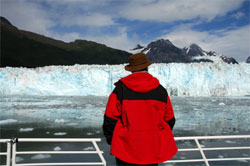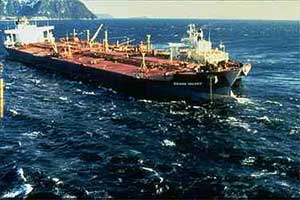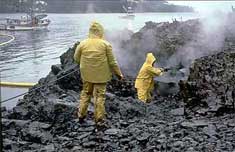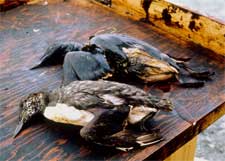The Exxon Valdez Oil Spill was the most devastating domestic oil spill in the United States. Its remote location (accessible only by helicopter and boat) made government and industry response efforts difficult and tested existing plans for dealing with such an event. The region is a habitat for salmon, sea otters, seals, and sea birds.

 On March 23, 1989, the oil tanker Exxon Valdez departed from the Valdez oil terminal in Valdez, Alaska (on its 28th voyage), heading south through Prince William Sound, with a full load of oil. Captain Joseph Hazelwood radioed to the Coast Guard station that he would be changing course in order to avoid some growlers, small icebergs which had drifted into the sound from the Columbia Glacier. The captain received permission to move into the northbound lane. Before retiring to his cabin, Captain Hazelwood instructed his third mate Gregory Cousins to "start coming back into the lanes" once the ship was abeam Busby Island Light (some 2 minutes ahead). Although Cousins did give the instructions to the helmsman to steer the vessel to the right, the vessel was not turning sharply enough and at 12:04 a.m. on March 24, the vessel hit Bligh Reef. It is not known whether Cousins gave the orders too late or the helmsman did not follow instructions properly. On March 23, 1989, the oil tanker Exxon Valdez departed from the Valdez oil terminal in Valdez, Alaska (on its 28th voyage), heading south through Prince William Sound, with a full load of oil. Captain Joseph Hazelwood radioed to the Coast Guard station that he would be changing course in order to avoid some growlers, small icebergs which had drifted into the sound from the Columbia Glacier. The captain received permission to move into the northbound lane. Before retiring to his cabin, Captain Hazelwood instructed his third mate Gregory Cousins to "start coming back into the lanes" once the ship was abeam Busby Island Light (some 2 minutes ahead). Although Cousins did give the instructions to the helmsman to steer the vessel to the right, the vessel was not turning sharply enough and at 12:04 a.m. on March 24, the vessel hit Bligh Reef. It is not known whether Cousins gave the orders too late or the helmsman did not follow instructions properly.
About 30 million US gallons (115,000 m³) of crude oil were spilled, affecting 1,900 km of coastline. A trial burn was conducted during the early stages of the spill, in a region of the spill isolated from the rest by a fire-resistant boom. The test was relatively successful, but because of unfavorable weather no additional burning was attempted in this cleanup effort. Mechanical cleanup was started shortly afterward using booms and skimmers, but the skimmers were not readily available during the first 24 hours following the spill and thick oil and kelp tended to clog the equipment. Transferring oil from temporary storage vessels into more permanent containers was also difficult because of the oil's weight and thickness. In addition, a trial application of dispersants was performed. The use of dispersants proved to be controversial. Less than 4,000 US gallons (15,000 L) of dispersant were available in Valdez, Alaska, and no application equipment or aircraft. A private company applied dispersants on March 24 with a helicopter and dispersant bucket. Because there was not enough wave action to mix the dispersant with the oil in the water, their use was discontinued.
  In the aftermath of the Exxon Valdez incident U.S. Congress passed the Oil Pollution Act of 1990, including a clause banning the Exxon Valdez from Alaskan waters. Exxon spent some 2 billion dollars cleaning up the spill, and a further 1 billion to settle civil and criminal charges related to the case. (Exxon recovered a significant portion of these monies via insurance claims and tax writeoffs.) An award of $287 million for actual damage and $5 billion for punitive damages was awarded by an Anchorage jury in 1994. Exxon appealed against the ruling and the 9th U.S. Circuit Court of Appeals ordered the original judge Russel Holland to reduce the amount. On December 6, 2002 the judge announced that he had reduced the damages to $4 billion, which he concluded was justified by the facts of the case and not grossly excessive. Exxon's company position is that no punitive damages are justified because the spill was an accident. However in court it was argued that allowing a "known drunk" to captain the ship was reprehensible. Exxon sent it back to court, to be considered in regard to a recent supreme court ruling in a similar case, resulting in Judge Holland actually upping the punitive damages to $4.5 billion, plus interest. Exxon is again appealing, some seventeen years after the incident. The case currently sits in the 9th Circuit appellate court, and oral arguments have been scheduled for January 27, 2006. The Exxon Valdez damages assessment is notable important in that it was the first which assessed the existence value of the environmental resource in question, an assessment which was done through the use of contingent valuation techniques. In the aftermath of the Exxon Valdez incident U.S. Congress passed the Oil Pollution Act of 1990, including a clause banning the Exxon Valdez from Alaskan waters. Exxon spent some 2 billion dollars cleaning up the spill, and a further 1 billion to settle civil and criminal charges related to the case. (Exxon recovered a significant portion of these monies via insurance claims and tax writeoffs.) An award of $287 million for actual damage and $5 billion for punitive damages was awarded by an Anchorage jury in 1994. Exxon appealed against the ruling and the 9th U.S. Circuit Court of Appeals ordered the original judge Russel Holland to reduce the amount. On December 6, 2002 the judge announced that he had reduced the damages to $4 billion, which he concluded was justified by the facts of the case and not grossly excessive. Exxon's company position is that no punitive damages are justified because the spill was an accident. However in court it was argued that allowing a "known drunk" to captain the ship was reprehensible. Exxon sent it back to court, to be considered in regard to a recent supreme court ruling in a similar case, resulting in Judge Holland actually upping the punitive damages to $4.5 billion, plus interest. Exxon is again appealing, some seventeen years after the incident. The case currently sits in the 9th Circuit appellate court, and oral arguments have been scheduled for January 27, 2006. The Exxon Valdez damages assessment is notable important in that it was the first which assessed the existence value of the environmental resource in question, an assessment which was done through the use of contingent valuation techniques.
 Both the long and short-term effects of the oil spill have been studied comprehensively. Thousands of animals died immediately; the best estimates include 250,000 sea birds, 2,800 sea otters, 300 harbor seals, 250 bald eagles, up to 22 orcas, and billions of salmon and herring eggs. Despite a thorough cleanup, and little visual evidence apparent even only one year later, the effects of the spill continue to be felt today. In the long term, reductions in population have been seen in various ocean animals, including stunted growth in pink salmon populations. Sea otters and ducks also showed higher death rates in following years, partly because they ingested contaminated creatures. The animals also were exposed to oil when they dug up their prey in dirty soil. Researchers said some shoreline habitats, such as contaminated mussel beds, could take up to 30 years to recover. Both the long and short-term effects of the oil spill have been studied comprehensively. Thousands of animals died immediately; the best estimates include 250,000 sea birds, 2,800 sea otters, 300 harbor seals, 250 bald eagles, up to 22 orcas, and billions of salmon and herring eggs. Despite a thorough cleanup, and little visual evidence apparent even only one year later, the effects of the spill continue to be felt today. In the long term, reductions in population have been seen in various ocean animals, including stunted growth in pink salmon populations. Sea otters and ducks also showed higher death rates in following years, partly because they ingested contaminated creatures. The animals also were exposed to oil when they dug up their prey in dirty soil. Researchers said some shoreline habitats, such as contaminated mussel beds, could take up to 30 years to recover.
 In additional to the environmental effects of the spill, the disruption to the lives of the people affected is noteworthy. Native American groups in the area were impacted, and the fishing industry also experienced serious changes as a result. For example, commercial fishing was closed for the remainder of 1989, so many fishermen went elsewhere to work. Unfortunately for the local industry, many seafood markets also turned elsewhere to purchase product, and some never returned. In the years following the spill, a very high percentage of the fishermen and associated companies declared bankruptcy. The promise of a punitive damages award from Exxon was not realized in the difficult years that followed the spill, and caused much frustration. For example, the mayor of Cordova, a nearby fishing community, committed suicide, and requested that his ashes be scattered on Bligh Reef, where the Exxon Valdez grounded. In additional to the environmental effects of the spill, the disruption to the lives of the people affected is noteworthy. Native American groups in the area were impacted, and the fishing industry also experienced serious changes as a result. For example, commercial fishing was closed for the remainder of 1989, so many fishermen went elsewhere to work. Unfortunately for the local industry, many seafood markets also turned elsewhere to purchase product, and some never returned. In the years following the spill, a very high percentage of the fishermen and associated companies declared bankruptcy. The promise of a punitive damages award from Exxon was not realized in the difficult years that followed the spill, and caused much frustration. For example, the mayor of Cordova, a nearby fishing community, committed suicide, and requested that his ashes be scattered on Bligh Reef, where the Exxon Valdez grounded.
|